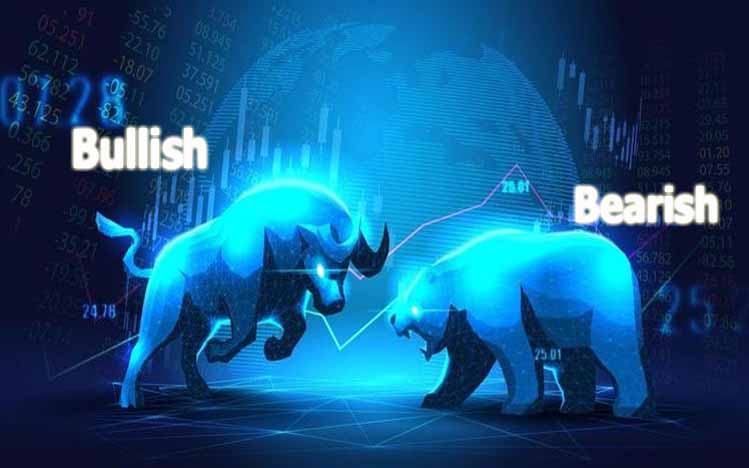
When you first jump into the stock market, cryptocurrency, or forex, there must be many terms that you don’t know the meaning of. Well, do you already know the meaning of the terms bullish and bearish that you will often encounter in the crypto world?
The words “bull” and “bear” which are the names of these animals are used to describe market conditions, whether the asset has increased in value (appreciation) or has decreased (depreciated).
The Beginning of the Emergence of the Terms Bullish and Bearish
What is Bullish and Bearish? These two terms are inspired by how a bull and a bear fight. When fighting, a bull will raise its horns up, while a bear will look down.
The term bull market is then used to describe a market situation where there is a continuous increase in value and an uptrend is expected by traders. This is the opposite of a “bear market”, which is a market condition that is weak (downtrend) and is not expected to last for a long time.
Other sources say that there used to be bearskin sellers who acted as intermediaries between producers and consumers. They will guess at the purchase price of the bear skin in the near future and expect the price to fall.
If the price goes down, they will benefit from the difference between the buying price and the selling price. The show of strength fighting between bulls and bears was popular at that time, so the term “bullish” was used to describe conditions that were the opposite of “bearish”.
The Importance of Learning the Terms Bullish and Bearish
Market trend is one of the fundamental aspects that can be interpreted as the overall direction that an asset or market is heading. This is influenced by the analysis of a fundamental and technical nature.
You certainly understand that the ability to analyze market conditions has a big impact on your portfolio. In addition, knowing the “bullish” and “bearish” conditions can make you wiser when making investment decisions.
Bull Market Characteristics
A bull market describes a market situation where the value of crypto assets tends to rise. Economic conditions are fine and it is not impossible that even an amateur trader can make a profit in this situation.
Because cryptocurrencies are also influenced by trader behavior, the term bull market is closely related to the trader’s optimistic attitude towards the ongoing economic trend. Within the scope of the country, the economy is strengthening (as indicated by the increase in the value of GDP) and the unemployment rate is low.
Bear Market Characteristics
In contrast to a bull market, a bear market indicates a declining value of crypto assets. In bearish conditions, the price of a security decreases by up to 20 percent within a certain period of time (usually two months or more).
This condition usually takes place in countries that are experiencing an economic downturn or recession. The economy is slowing and the unemployment rate is rising as more layoffs occur. Certain policies, such as changing the tax percentage by the government, can also exacerbate bear market conditions.
Mechanism of Bull Market and Bear Market
The causal relationship between supply and demand applies here. In a bull market, traders are competing to buy crypto assets because they believe that prices will continue to soar and they can reap big profits. In a bear market, traders sell more than they buy, which causes prices to fall.
These two phenomena are also related to the sentiment and perspective of traders. Negative sentiment in which traders withdraw and allocate their money to other investments that promise fixed income can certainly trigger bearishness.
Trader’s Ideal Response to Bull Market and Bear Market
Both when facing a bull market and a bear market, an ideal response is needed so that you can optimize profits and minimize losses.
In bullish conditions you can sell some of your crypto assets to profit from the difference between the selling price and the buying price. Meanwhile, in bearish conditions, you can do a short selling strategy.
Short selling is a transaction where you borrow a crypto asset from a broker for later selling at a high price. However, because you are in debt, of course there is something you have to return to the broker. You then buy the same crypto asset again at a lower price. You will still profit from the difference between the selling price and the buying price of the crypto.
For another, less risky alternative, you can exercise your rights in a put option. That is, you as a holder will be shown a contract in which you have the right to sell your crypto assets at the price stated in the contract.
There is no coercion in this contract. However, this transaction is considered safer than short selling, especially when you can already predict that the price will fall further.
In addition, some traders usually switch from cryptocurrencies to defensive stocks, where these stocks offer constant returns and are not affected by changing trends in the market.
These shares are offered by government-run companies. The company sells people’s basic needs so that the goods will continue to be purchased regardless of the current economic situation.
Conclusion
Each type of investment instrument certainly comes with its own opportunities and risks. You don’t need to panic when the market is bearish, especially if your investment is for the long term.
Take advantage of the momentum as well as possible so that you can achieve your investment goals. Momentum in the cryptocurrency world is the best time to buy or sell your assets. This sensitivity and analytical ability are what you need to train to become a reliable investor or trader.
(*)


